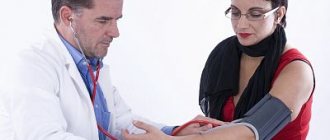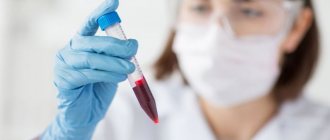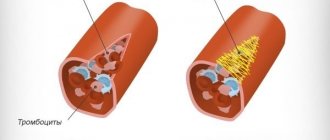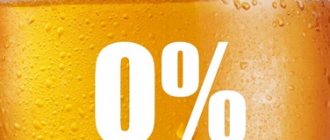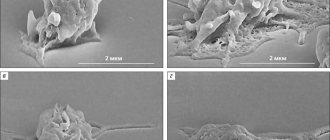Hypotension (low blood pressure) is considered normal in approximately 15% of the population. This term refers to a stable decrease in the resistance force of the vascular walls that occurs during blood circulation by more than 20% of the existing physiological norms. In almost half of the cases, the pathology is asymptomatic and does not in any way affect the patient’s well-being, but in some, even a slight deviation to a lesser extent can cause severe symptoms: headaches, migraine attacks, decreased performance. With an abrupt course of hypotension, the patient often feels dizzy.
Many people believe that only hypertension poses a danger to life, but this is not true. If hypotension has a chronic or spasmodic course, or the pressure periodically decreases to critical levels, the consequences can be very serious - even coma and death of the patient. To prevent this, you need to know the dangers of low blood pressure and be able to provide emergency care during a hypotensive crisis.
Low blood pressure - what is it?
A normal blood pressure is considered to be 120/80 mmHg. The upper indicator characterizes the force of compression of the heart muscle at the moment of pushing blood into the coronary arteries and is called systolic pressure. Diastolic pressure is the resistance force of the walls of arteries, vessels and capillaries at the moment the heart relaxes. If these indicators differ from acceptable limits, the patient is diagnosed with hypertension or hypotension.
The term “hypotension” refers to a chronic decrease in blood pressure, combined with disorders of the autonomic nervous system. Many factors can trigger an attack, for example:
- sedentary lifestyle;
- smoking;
- emotional shock;
- chronic stressful situations at home or at work;
- alcohol abuse;
- a large amount of fatty foods and foods with chemical additives in the diet;
- chronic diseases.
Before diagnosing a patient with arterial hypertension, the doctor assesses his condition and the degree of influence of deviations on the patient’s well-being. Almost half of people do not notice low blood pressure and live in their usual rhythm. In this case, a moderate deviation from the norm is not considered a pathology and does not require drug correction if all internal organs function without disturbances.
Doctors distinguish three types of hypotension, each of which differs in clinical symptoms and has its own consequences.
| Degree of disease | Upper pressure (mmHg) | Lower pressure (mmHg) |
| 1st degree | 100-115 | 70-75 |
| 2nd degree | 70-100 | 60-70 |
| 3rd degree | ≤ 70 | ≤ 60 |
Important!
Hypotension of the 3rd degree is the most dangerous for humans. If a patient’s blood pressure does not rise above 70/60 for a long time, the consequences can be very severe, therefore, even in the absence of external manifestations, you should consult a doctor with such a clinical picture.
Is low blood pressure dangerous?
Many people - most often thin women - live with hypotension for years and feel great. Doctors believe that these people are lucky: they are less likely to suffer from cardiovascular diseases.
However, if your blood pressure suddenly drops below normal levels, unpleasant symptoms may appear:
- blurred vision;
- dizziness;
- fainting;
- nausea or vomiting;
- drowsiness;
- feeling of weakness.
As a rule, at a young age, the health risk is associated not with low blood pressure itself, but with the reasons due to which it falls. The exception is fainting. “This is the most alarming symptom, since it often leads to injuries and accidents,” says Oksana Dikur, general practitioner, cardiologist at the Rassvet clinic. “If hypotension is accompanied by loss of consciousness, you should definitely consult a doctor.”
But for older people, low blood pressure can be really dangerous. Moreover, a drop in diastolic pressure is more dangerous than a decrease in systolic pressure.
“This can lead to deterioration of blood supply to the kidneys and brain, increasing the risk of stroke and kidney failure,” explains Oksana Dikur.
Cerebrovascular accident
Almost always, with hypotension, the movement of blood through the blood vessels is disrupted, and blood stagnation occurs. This leads to the fact that internal organs do not receive enough nutrients and oxygen necessary for their normal functioning. The main function of blood is to transport oxygen molecules, vitamins and other useful elements to tissues and cells. The brain suffers the most from lack of oxygen.
This can manifest itself as constant headaches, fatigue, decreased concentration, and drowsiness. With low blood pressure, a person constantly feels tired and cannot get enough sleep, even if the duration of sleep is the physiological age norm (8-9 hours). In acute hypoxia, he may lose consciousness. If at this time there is no one nearby who could provide the necessary assistance or call a medical team, the pathology may result in the death of the patient.
Note!
Lack of oxygen can cause cerebrospinal fluid to accumulate in the ventricles of the brain space. This pathology is called hydrocephalus of the brain. This is a very dangerous condition, which, if left untreated, can cause irreversible disturbances in the transmission of nerve impulses. In addition, cerebral hydrocele increases the risk of strokes and micro-strokes by almost 5 times.
Standard indicators
Blood pressure is the force acting on the blood vessels. The definition of “arterial” refers to vascular pressure parameters. There are:
- venous;
- capillary;
- heart pressure.
Standard blood pressure indicators for vital functions are 120/80 (maximum 140/90). If the value is too high, there is a tendency towards hypertension. Maximum - the upper pressure is systolic, the heart muscle contracts. Minimum – diastolic (relaxation phase).
To determine the optimal blood pressure value, it is not necessary to focus on established standards. A person may well have individual characteristics of blood pressure. If there are non-standard indicators, you should pay close attention to your health and consult a doctor.
Pulse is an indicator of blood pressure. The norm for humans is 60-80 beats. /min. By measuring your heart rate, you can learn about an upcoming problem. If the number of heartbeats increases after 2-3 hours after eating, food poisoning can be detected. During magnetic storms, a decrease in blood pressure is observed. In response to this, the heart rate increases to maintain optimal blood pressure levels.
Heart problems
Low blood pressure is dangerous not only for brain cells, but also for the main muscular organ of the human body - the heart. Not only a lack of oxygen, but also an insufficient supply of minerals, including:
- calcium;
- potassium;
- magnesium;
- phosphorus.
If the pressure is constantly lowered, the blood flow slows down and its circulation is disrupted. The result may be the development of chronic or acute heart failure. People suffering from stable low blood pressure should know that acute heart failure is a deadly pathology, the management of which requires certain knowledge and skills.
Almost 70% of people with various forms of hypotension have ischemic myocardial damage. Coronary artery disease is one of the most common causes of heart attacks, so prevention of this disease and timely treatment of any heart and vascular diseases are of great importance.
Important!
The most severe consequence of hypotension is cardiogenic shock - this is heart failure of the left ventricle, which has an extreme degree and leads to the cessation of blood supply to vital organs. Cardiogenic shock is almost always accompanied by cardiac arrest and in most cases ends in the death of the patient.
Reasons for measuring blood pressure
The reasons for changing the parameters are as follows:
- Lack of ability of the heart muscle to function normally, as before.
- Changes in blood quality parameters. As you age, your blood thickens. The higher the degree of its density, the harder it moves through the vessels. The causes of blood thickening can be diabetes and autoimmune pathological diseases.
- Decreased elasticity of blood vessels. The causes of this condition are poor nutrition, exceeding the limit of permissible physical activity, and a certain list of medications.
- The formation of atherosclerotic plaques that appear in the bloodstream as a result of high concentrations of “bad” cholesterol in the body.
- A sharp decrease in the lumen of blood vessels, provoked by hormones.
- Incorrect activity of the endocrine system.
Danger of hypotension during bleeding
Low blood pressure during various bleedings is very dangerous, especially if they take a latent form. In women, breakthrough uterine bleeding that lasts more than 3-5 days is considered the most dangerous. With any blood loss, blood pressure decreases by approximately 10-15% of normal values. If a person suffers from hypotension, the readings can become critical. The consequences in this case may be:
- severe dehydration;
- anaphylactic shock;
- renal failure (in severe cases, organ dysfunction);
- coma.
The chances of a favorable prognosis for bleeding against the background of severe hypotension depend on the speed of resuscitation, so in case of any bleeding there is no need to try to stop the bleeding yourself. The most reasonable decision would be to seek medical help.
Content:
- What is hypotension?
- Low blood pressure - causes
- Low blood pressure - symptoms?
Arterial pressure
– the main indicator of hemodynamics, which determines the speed and volume of blood flow in all tissues. The condition refers to polyetiological pathological processes. This means that it develops due to the influence of several causes. Clinical symptoms include manifestations of hemodynamic disturbances with oxygen starvation of tissues.
Vegetative-vascular disorders
Very often, against the background of low blood pressure, people develop vegetative-vascular dystonia. It can manifest itself in different ways, but it always negatively affects the patient’s quality of life, limiting his mobility. A person with various forms of vegetative-vascular disorders constantly experiences headaches, the intensity of which can reach such an extent that the patient confuses this symptom with a migraine attack. In the morning, stiffness of muscles and joints and nausea may appear, independent of food intake.
Against the background of VSD, appetite is disrupted, severe fatigue and weakness appear. In severe cases, the patient may completely lose ability to work. This is especially true for office workers who use a computer during the working day, and for knowledge workers. Students suffering from hypotension have a hard time preparing for exams because they are unable to concentrate on the material and remember it.
If there are disturbances in the functioning of the autonomic nervous system, other pathologies may appear in a person, for example:
- change in taste sensations;
- dizziness;
- pain of unknown etiology in the chest, temporal and occipital parts of the head;
- lack of coordination.
Important!
With a systematic decrease in blood pressure, the patient often experiences behavioral changes: aggression and moodiness appear. The mood can change dramatically without any reason. Such manifestations are difficult for others to perceive, which can cause difficulties with adaptation in teams and lead to problems with socialization.
Treatment
Help before diagnosis
When experiencing low blood pressure, a person needs to lie down with their legs raised up. It is necessary to open the windows to allow fresh air to enter. If you feel faint, rinse your face and neck with cool water. The patient is given strong sweet tea or coffee and a caffeine tablet to drink. For short-term hypotension, these actions are enough to normalize the condition. If your health worsens, urgent medical attention is required.
Drug therapy
The first step in treating low blood pressure is normalizing lifestyle, physical activity and nutrition. If the condition is caused by taking antihypertensive medications, the dose is adjusted or the drug is replaced. When selecting conservative measures, they are based on the main cause of hypotension. The following groups of drugs are used to treat low blood pressure:
- Iron supplements
. Prescribed for iron deficiency anemia in the form of oral or parenteral forms. For low hemoglobin levels due to vitamin deficiency, cyanocobalamin B12 and folic acid preparations are recommended. - Adaptogens
. Medicines based on plant extracts are designed to increase the body's adaptive capabilities. They are effective for physiological causes of low blood pressure and as an addition to etiopathogenetic therapy of other types of hypotension. - Nootropics
. The drugs are prescribed to eliminate cognitive impairment that is caused by chronic insufficiency of cerebral blood supply. To enhance the effect, nootropics are taken in combination with cerebroprotectors and antioxidants. - Adrenergic agonists
. Indicated for emergency care in shock conditions accompanied by a sharp drop in blood pressure. The most commonly administered hormonal drugs are adrenaline and norepinephrine. In critical conditions, analeptics are also used.
Physical inactivity
Low blood pressure also affects the level of physical activity. Constantly feeling unwell, headaches, and dizziness prevent you from doing your usual activities and moving at an active pace. Particularly unpleasant symptoms manifest themselves when bending forward and turning the head. Climbing stairs and running, even at a moderate pace, cause pulsation in the temples, shortness of breath, pain in the heart, so a person is forced to limit the usual level of movement.
This also does not go unnoticed. The consequences of a sedentary lifestyle can be:
- weight gain (due to fat mass);
- joint problems;
- muscle weakness;
- disruption of oxygen transport to the heart and other vital organs;
- diseases of the musculoskeletal system (osteochondrosis, scoliosis).
Note!
In addition to health problems, physical inactivity due to low blood pressure has a very negative impact on the patient’s quality of life. It becomes difficult for a person to do usual things: he cannot wash the floors, vacuum the apartment, or go to the grocery store. If urgent measures are not taken to eliminate the problem, even walking alone will become inaccessible for a person, since he will constantly need the help of others due to poor health.
What is the danger?
The danger of hypotension is that it is not always an independent disease; very often it is only a symptom of more serious conditions.
Advertising:
Low blood pressure for more than one month can be a manifestation of diseases of the nervous system, gastrointestinal tract, adrenal dysfunction and the acute onset of myocardial infarction.
Squamous epithelium is the cells that form the mucous layer of the internal genital organs. They can be found in the vagina, urethra and cervix. The main function of the epithelium is the secretion of a special type of cells that prevent infection and protect against injury. Read more in the article: “epithelium: the norm in women.”
It is worth visiting a medical facility immediately if, as a result of the disease, loss of consciousness, lack of coordination of movements, blurred vision, pain in the heart, memory impairment, or slow reactions occur. Without treatment, the consequences can be very serious.
Risks during pregnancy
Hypotension in pregnant women is considered normal and occurs in approximately every third woman expecting a child. It is very important to constantly monitor your well-being and avoid sudden surges in pressure. The main consequence of pathology during pregnancy is hypoxia. If there is not enough oxygen in a woman’s blood, oxygen starvation also develops in the fetus, since the child receives all substances (including nutrients, vitamins and oxygen) through the placenta, which is riddled with blood vessels. Blood enriched with all necessary elements flows through the placenta to the baby from the mother.
Fetal hypoxia is a very dangerous condition that can cause congenital developmental defects and defects of the genitourinary, nervous, cardiac and other important systems of the body. Among them:
- congenital heart defects;
- tachycardia and bradycardia;
- renal failure;
- disturbances in the functioning of the liver (cirrhosis, biliary atresia);
- hydrocephalus;
- Cerebral palsy.
Even if a child is not diagnosed with severe congenital diseases, he may lag behind his peers in development, gain weight poorly, and have difficulty falling asleep. When a child turns 2-3 years old and goes to kindergarten, problems with adaptation and communication may appear.
Important!
In 35% of cases, birth in women with chronic hypotension occurs prematurely. Prematurity increases the risks of various diseases and disorders in the functioning of internal organs, so it is important to treat low blood pressure if the doctor insists on it. The most dangerous period in this regard is considered to be the period from 20 to 24 weeks.
Hypotension is a disease that is not considered dangerous and is usually ignored unless accompanied by severe clinical symptoms. Many people do not know why low blood pressure is dangerous, so they do not take any measures to correct the condition and do not consult a doctor. This attitude to the problem can lead to quite unpleasant (and in some cases very serious) consequences, half of which have a high percentage of deaths. To prevent this, you need to regularly monitor your blood pressure using a home blood pressure monitor and consult a doctor if, for three measurements in a row at an interval of a week, your blood pressure is more than 10 units below the established standards.
Video - Is low blood pressure really safe?
Video - About low blood pressure
How do foods affect blood pressure?
Blood pressure is affected by both the composition of a person's diet and their eating habits, including how often they eat, how large their portions are, and how much fluid they drink. A healthy, balanced diet is one of the conditions for maintaining a healthy cardiovascular system, normal heart function and optimal blood counts. All this is directly related to blood pressure values.
What foods increase blood pressure?
There are a number of food products that increase the tone of the walls of blood vessels, the volume of fluid (and blood pumped), and also compensate for the deficiency of vitamins associated with hypotension.
Blood pressure increases when you eat the following foods:
- Salt, additives, seasonings containing sodium: retain fluid, increasing its volume in the body, increasing the volume of blood pumped. Salt intake should not be too high even with hypotension. WHO recommends consuming no more than 5 g of salt daily (1 teaspoon).
- Products containing caffeine: coffee, green tea, cocoa, strong sweet tea tone up and increase heart rate.
- High-calorie dishes. Baked goods, meat products, cheese, sweets, and high-fat dairy products provoke an increase in blood sugar, which causes blood pressure to rise. It is important for people with hypotension to eat foods that are nutritious enough, but they need to be careful that they are not excessively high in calories or contain too many carbohydrates or saturated fats.
- Products containing vitamins C, B12, E. With a deficiency of these vitamins, anemia develops, which is associated with the appearance of hypotension. By normalizing their consumption, you can reduce its manifestations. Citrus fruits, parsley, and red bell peppers contain a lot of vitamin C. Vitamin B12 is found in eggs, meat, and dairy products. Vegetable oil, avocados, and nuts contain a lot of vitamin E.
Important! Some foods prohibited for hypertensive patients can increase blood pressure: fatty, fried, too spicy foods, but using them to cope with hypotension is not recommended. Such food increases cholesterol levels in the blood, has a bad effect on the digestive system, and can cause additional health problems.
Foods that sharply increase blood pressure
Hypotension can make a person feel unwell, and it is important to know what to eat to raise blood pressure quickly. The following will help you feel better:
- black coffee;
- strong black tea;
- bitter chocolate;
- salty foods (this could be salted cheese, pickled vegetables, salted fish);
- prunes, dried apricots or other dried fruits;
- pomegranate juice;
- honey.
These products should only be used if it is known for sure that poor health is caused by hypotension. You can verify this by measuring your blood pressure. If symptoms associated with hypotension appear frequently, you should consult a doctor (general practitioner or cardiologist) and follow his recommendations.
Coffee and chocolate contribute to a rapid increase in blood pressure. Photo: nanka-photo / Depositphotos
What foods increase blood pressure during pregnancy?
In the first half of pregnancy, against the background of hormonal changes, blood pressure may decrease due to a decrease in the tone of the walls of blood vessels. This is normal, but if you experience symptoms associated with hypotension, you should inform your doctor. Blood pressure levels should return to normal after childbirth. If it becomes low during pregnancy, you need to make sure that this is not caused by anemia (for this, a blood test is taken).
To increase blood pressure during pregnancy, only certain foods can be used: chocolate, tea, pomegranate juice. Even they are not advisable to consume in large quantities so that the pressure does not become too high. This can be dangerous. It is also undesirable to increase the consumption of water or coffee (this may create additional stress on the kidneys), spicy, fatty, salty or too high-calorie foods. It is better to consult with your doctor and get nutritional recommendations from him, taking into account your general health, the duration of your pregnancy, and the characteristics of its course.
During pregnancy, you should be more careful when choosing your diet. Photo: Amina Filkins: Pexels
What foods should you not eat if you have high blood pressure?
Some foods can not only normalize blood pressure, but also increase it excessively. Eating these foods may be dangerous if a person already has hypertension. In this case, follow a special diet, excluding or limiting the consumption of the following foods:
- salt, seasonings, food additives containing sodium;
- strong tea, coffee containing caffeine;
- fatty, fried, spicy foods;
- pickles and canned foods;
- smoked meats;
- baked goods, sweets;
- fast food;
- sweet carbonated drinks;
- ready-made sauces, seasonings, flavor enhancers, and other additives that may contain sodium;
- frozen semi-finished products: pizza, dumplings and other similar dishes (may contain a lot of sugar, sodium, saturated fat to preserve taste);
- alcohol.
To prevent excessive stress on the heart and the appearance of essential hypertension, you need to adhere to a healthy, balanced diet in the same way as when preventing hypotension. Both hypertensive and hypotensive patients are equally benefited from fresh vegetables, nuts, herbs, fruits, whole grains, lean meat, poultry and fish. If your blood pressure is high, you need to eat more foods containing potassium, magnesium, and calcium. Bananas, beans, spinach, and sunflower seeds are especially useful.
Why does blood pressure rise?
Pressure fluctuations don't just happen. Blood pressure values are influenced by factors that are not always related to the incorrect functioning of the body. Increased blood pressure - review of lifestyle and diet.
Factors that cause increased blood pressure:
- Dehydration. The norm for human fluid intake is 2 liters, the water must be clean. In the absence of the required amount of water, the blood thickens, the heart functions at the maximum permissible speed, which provokes an increase in blood pressure.
- Eating fatty foods with significant cholesterol levels. Cholesterol plaques settle on the walls, interfering with the movement of blood through the vessels.
- High salt intake.
- Having bad habits.
- Frequent heavy physical activity, as well as lack thereof. With increased loads, disruptions in orgasm are observed, with physical inactivity, the outflow of blood worsens, and the strength of the heart muscle weakens.
- Frequent stressful situations.
- Heredity, menopause, kidney failure, head injuries.
Hypertension or hypotension?
Patients often wonder which of the critical pressure values is worse. In a comparative analysis of the conditions, it is obvious that in terms of the dangerous consequences of complications, hypertension is worse than hypotension. The ideal value is normal blood pressure according to medical experts.
Achieving ideal pressure parameters for hypotension is possible with the use of tonic drinks containing caffeine, ginseng and other stimulants. For hypertensive patients, systematic consumption of special medications that control blood pressure is mandatory.
Most of the causes of sharp fluctuations in critical blood pressure can be eliminated on your own, which will make it possible to preserve your health for a longer time. A properly selected, balanced diet, activity and physical activity, a calm attitude towards events in life, avoidance and elimination of stressful situations is the path to health and longevity. Compliance with these simple rules will normalize blood pressure levels.


